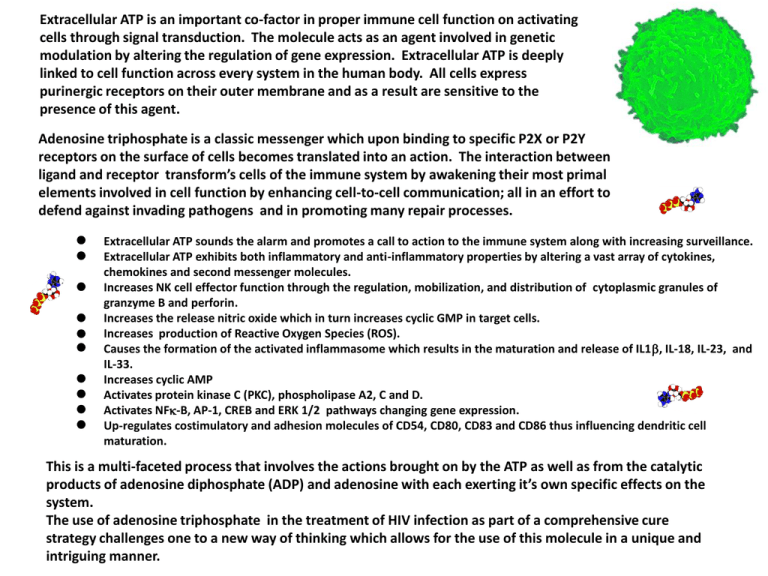ATP 3: Lymph Nodes DOWNLOAD
advertisement

Extracellular ATP is an important co-factor in proper immune cell function on activating cells through signal transduction. The molecule acts as an agent involved in genetic modulation by altering the regulation of gene expression. Extracellular ATP is deeply linked to cell function across every system in the human body. All cells express purinergic receptors on their outer membrane and as a result are sensitive to the presence of this agent. Adenosine triphosphate is a classic messenger which upon binding to specific P2X or P2Y receptors on the surface of cells becomes translated into an action. The interaction between ligand and receptor transform’s cells of the immune system by awakening their most primal elements involved in cell function by enhancing cell-to-cell communication; all in an effort to defend against invading pathogens and in promoting many repair processes. Extracellular ATP sounds the alarm and promotes a call to action to the immune system along with increasing surveillance. Extracellular ATP exhibits both inflammatory and anti-inflammatory properties by altering a vast array of cytokines, chemokines and second messenger molecules. Increases NK cell effector function through the regulation, mobilization, and distribution of cytoplasmic granules of granzyme B and perforin. Increases the release nitric oxide which in turn increases cyclic GMP in target cells. Increases production of Reactive Oxygen Species (ROS). Causes the formation of the activated inflammasome which results in the maturation and release of IL1b, IL-18, IL-23, and IL-33. Increases cyclic AMP Activates protein kinase C (PKC), phospholipase A2, C and D. Activates NFk-B, AP-1, CREB and ERK 1/2 pathways changing gene expression. Up-regulates costimulatory and adhesion molecules of CD54, CD80, CD83 and CD86 thus influencing dendritic cell maturation. This is a multi-faceted process that involves the actions brought on by the ATP as well as from the catalytic products of adenosine diphosphate (ADP) and adenosine with each exerting it’s own specific effects on the system. The use of adenosine triphosphate in the treatment of HIV infection as part of a comprehensive cure strategy challenges one to a new way of thinking which allows for the use of this molecule in a unique and intriguing manner.











